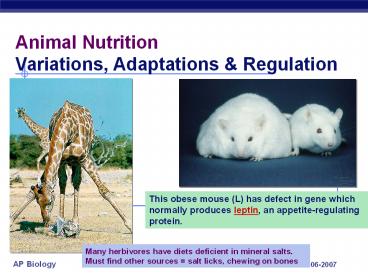Animal Nutrition - PowerPoint PPT Presentation
1 / 16
Title:
Animal Nutrition
Description:
Animal Nutrition Variations, Adaptations & Regulation This obese mouse (L) has defect in gene which normally produces leptin, an appetite-regulating protein. – PowerPoint PPT presentation
Number of Views:161
Avg rating:3.0/5.0
Title: Animal Nutrition
1
Animal Nutrition Variations, Adaptations
Regulation
This obese mouse (L) has defect in gene which
normally produces leptin, an appetite-regulating
protein.
Many herbivores have diets deficient in mineral
salts. Must find other sources salt licks,
chewing on bones
2
Energy budget
- basal (resting) metabolism
- temperature regulation
- activity
food intake
- repair
- growth
- reproduction
- glycogen
- fat
3
Energy storage
- In humans
- glycogen storage
- glucose polymer
- in liver muscle cells
- If glycogen stores are full caloric intake
still exceeds caloric expenditure - excess stored as fat
- synthesis pathwayfrom acetyl coA
Why isglycogen highlybranched?
4
Balancing calorie needs with intake
- When fewer calories are taken in than are
expended, fuel is taken out of storage deposits
oxidized (digested) - breakdown (digest) glycogen from liver muscle
cells - metabolize (digest) fat
Just do it!
5
Vegetarian diets
- Need to make sure you get enough protein
- 20 amino acids to make protein
- humans can synthesize 12 of the amino acids
- 8 have to be eaten essential amino acids
- Grains (like corn) have 6 (missing 2)
- Beans (like soybean red beans) have 6 (missing
different 2) - mix beans grainsfor complete group of amino
acids - rice beans
- taco/tortilla beans
- tofu rice
- peanut butter bread
What no fish!
6
Eating a balanced diet
- What happens if an animals diet is missing an
essential nutrient? - deficiency diseases
- scurvy vitamin C (collagen production)
- rickets vitamin D (calcium absorption)
- blindness vitamin A (retinol production)
- anemia vitamin B12 (energy production)
- kwashiorkor protein
7
Digesting cellulose
- How well you digest cellulose governs life
strategy of herbivores
bond between the sugars governs digestibility
8
- Cow
- can digest cellulose well no need to eat
supplemental sugars - Gorilla
- can NOT digest cellulose well must supplement
with sugar source, like fruit
9
Different diets different bodies
- Adaptations of herbivore vs. carnivore
- specialization in teeth
- length of digestive system
- number size of stomachs
10
Teeth
- Carnivore
- sharp ripping teeth
- canines
- Herbivore
- wide grinding teeth
- molars
- Omnivore
- both kinds of teeth
11
Length of digestive system
Rememberthe rabbits,George!
- Carnivores
- short digestive system
- protein easier to digest than cellulose
- Herbivores omnivores
- long digestive system
- more time to digest cellulose
- symbiotic bacteria in gut
12
Symbiotic organisms
- How can cows digest cellulose efficiently?
- symbiotic bacteria in stomachs help digest
cellulose-rich meals - rabbit vs. cow adaptation eat feces vs. chew cud
ruminant
caprohagy
Ruminants additional mechanical digestion by
chewing food multiple times after mixing it with
enzymes
13
Regulation of Blood Sugar
Feedback Maintaining Homeostasis
insulin
body cells takeup glucose from blood
liver storesglucose asglycogen
reducesappetite
blood glucose level (90 mg/100 mL blood)
liver releasesglucose
triggershunger
glucagon
14
Managing glucose levels
- Mammals regulate use storage of glucose
- insulin reduces blood glucose levels
- glucose levels rise above set point, pancreas
secretes insulin - promotes transport of glucose into cells
storage of glucose (as glycogen) in liver
muscle cells - drops blood glucose levels
- glucagon increases blood glucose levels
- when glucose levels drop below set point,
pancreas secretes glucagon - promotes breakdown of glycogen release of
glucose into the blood - raises blood glucose levels
Whoa! Didnt realizeI was so busy!
15
Regulation of Digestion
Coordination of nervous system endocrine system
Liver
Stomach
Proteins
Gastrin
Gallbladder
Gastricinhibitory peptide
Parietalcells
Bile
Chiefcells
Pepsin
Pancreas
HCl
Duodenum
Acinarcells
Fats
Enzymes
CCK
Bicarbonate
Secretin
16
Dont be shy Ask Questions!!































